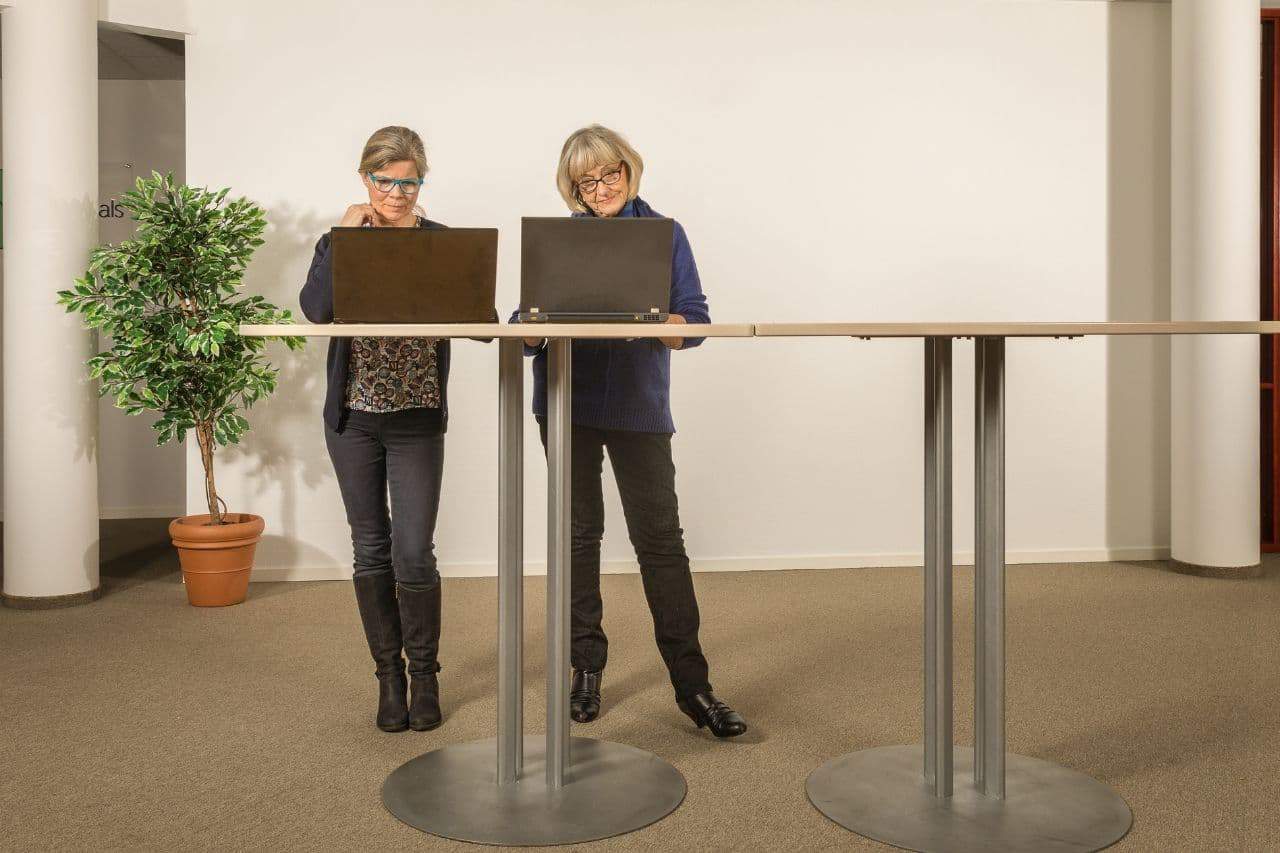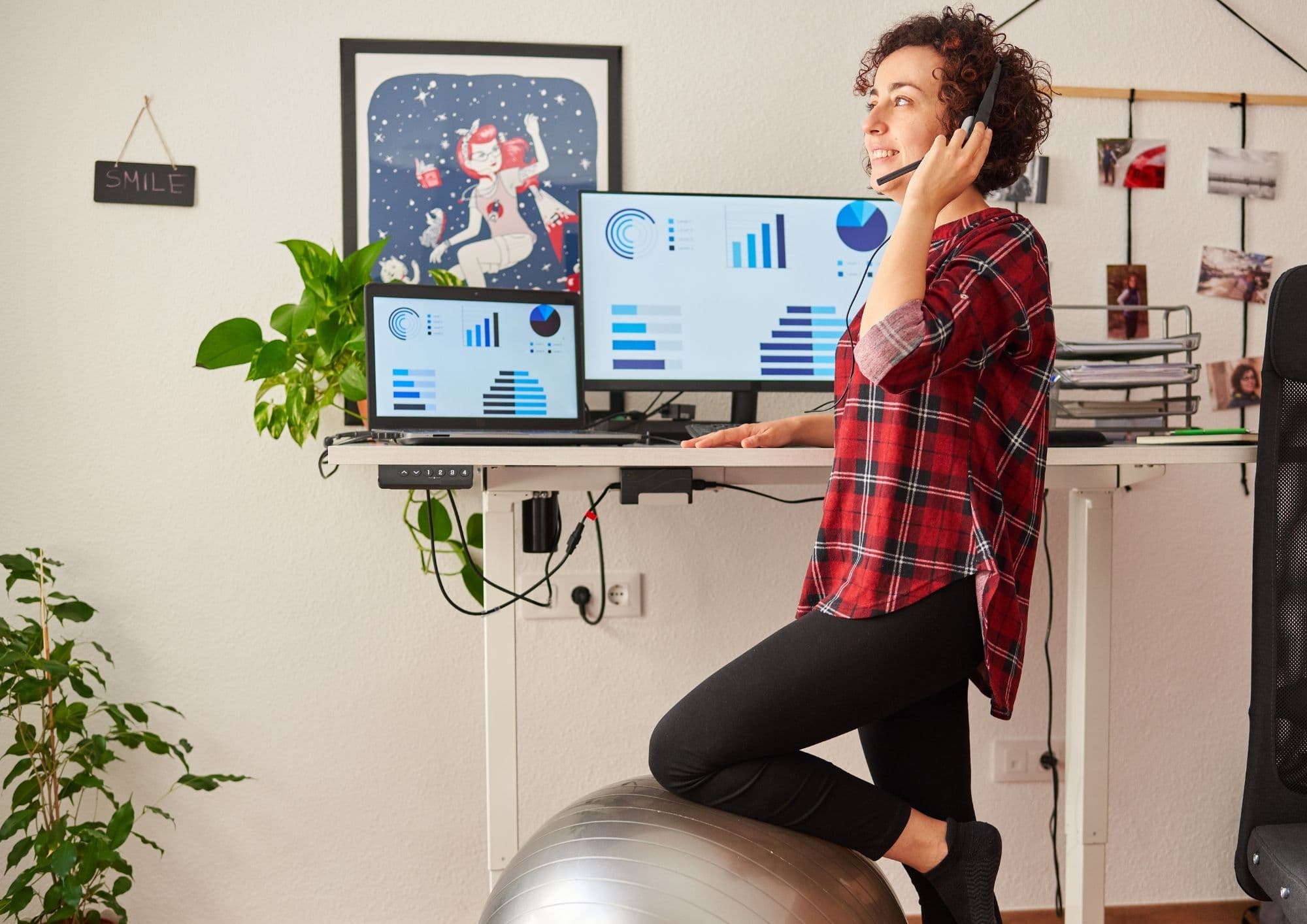Sitting for hours can lead to health problems ranging from musculoskeletal disorders (MSDs) to high blood pressure. That is why standing from time to time is encouraged in the workplace.
However, one might also wonder if a standing desk has its risks. Is standing too long bad for knees?
We’ll answer this question by discussing proper standing desk usage and risk prevention.
Anything In Excess Is Bad For You, Actually
So, let us go back to the question: is standing too long bad for knees? The thing is, it’s a lot like sitting too long at work.
Stand too long using a standing desk, and you become at risk of MSDs and other similar health risks associated with prolonged sitting.
You have to use a standing desk properly to avoid knee problems. Despite the furniture name, it does not mean that you have to stand all day while using it.
To avoid body pains and health issues, we need to sit and stand the right way at work. Let us discuss all these further in this article.
What Risks Are Associated With Prolonged Standing?
Anything done in extremes is no good for you. The same thing applies to standing.
The focus was always on the dangers of prolonged sitting. But several studies pointed out that excessive standing habits also cause health conditions like cardiovascular illnesses and chronic back pain.
Garcia and colleagues, for instance, reported that sustained muscle fatigue due to prolonged standing causes severe joint problems.
The authors further noted that work-related MSDs due to long-term standing are problematic for workers, the companies they work for and society.
Their findings also showed that nearly half of all workers in the world spend over three-fourths of their workday standing up.
Garcia and others stressed that more than 2 hours of standing has harmful effects. And while prolonged standing is known to cause temporary health problems like backaches and leg cramps, their research aimed to identify long-term issues.
Their study has 14 men and 12 women participants. Half of them were 18-30 years old, while the other half were 50-65 years old.
They did not have any history of MSD or neurological disorder. And a day before the study, they did not do any physically demanding labour.
The participants performed light tasks while standing at a workbench for 5 hours during the actual research. They also had a maximum of 5 minutes for rest and 30 minutes for lunch.
The researchers observed leg muscle stress, later measured as muscle twitch force, with posture stability during the study. The participants were also requested to express any experience of discomfort.
Results showed clear indications of muscle fatigue among participants. Specifically, they experienced it for over 30 minutes after the standing phase.
Findings also indicated that this condition happens regardless of gender or age.

How Long Should You Stand At A Standing Desk?
So, if prolonged standing causes health risks, can standing desk be bad for you? Not necessarily.
Like any other device or fixture, we need to observe proper standing desk use to counter harmful effects and reap the benefits.
Specifically, you can stand at this specific desk for 30-60 minutes at a time. That means you must spend an hour of your work time standing for each hour or two that you spend seated.
It might seem a bit tedious to do and track. But combining both sitting and standing at work help prevent the health risks associated with both positions.
Think of it as gaining the benefits that both standing and sitting can provide.
How To Make Standing Desk Easier On The Knees
Knee pain while using a standing desk is preventable. Here are a few helpful tips on correct standing desk use to ease and prevent those aches and pains.
1. Find The Right Balance
Once you have your new standing desk, help your body gradually adapt to it. Do not suddenly switch to standing all day at work if you’re used to sitting for extended periods.
Try standing for half an hour first. Then add 15 minutes to your standing time daily until you get your best standing/sitting ratio.
Spend more time sitting down if you experience knee discomfort after using the desk. Just adjust when you’re ready and more comfortable.
2. Practice Proper Posture
Having proper posture during standing desk use is essential. Avoid using the desk as support. And do not lean on it either.
Remember to maintain a straight back. Make sure that your weight is also balanced consistently between the legs.
Since you will be standing for a maximum of one hour, avoid locking your knees and ankles in one position. Also, avoid hunching over while standing or sitting to prevent straining your neck and shoulders.
3. Add Movement
Do not remain in one position only when using your standing desk. Add movements while at work. Try fidgeting from time to time, walking in place or rocking yourself back and forth.

4. Wear The Right Footwear
The right shoes contribute to your overall comfort during standing desk use. Go for shoes that are supportive and comfortable.
They should fit you right and take in the shock while you’re walking and standing. The ladies should avoid high heels that affect their posture and do not provide sufficient support, too.
5. Do Some Stretches
Doing a bit of stretching helps in alleviating knee pain. Here’s how to do it.
Put your hands on the desk and budge any of your feet as far as you can. Make sure to keep the heels flat.
Advance onwards while bending the knee moderately. Hold this position, then do the same to the other leg.
6. Walk Once In A While
Add more movements to your sitting and standing routine by walking around. Talk to a co-worker, organise papers, go to the ladies or men’s room, deliver paperwork or refill your water bottle.
Take these breaks every half hour or so.
7. Use Anti-fatigue Mats
Make those standing periods more comfortable by complementing the desk with an anti-fatigue mat. Anti-fatigue mats can minimise fatigue caused by prolonged standing on hard surfaces.
They are available in different materials like vinyl, rubber and textile. Some come in wood, too.
Conclusion
Can standing desk be bad for you? Research suggests that prolonged and improper standing desk use can indeed cause harm.
Sitting or standing for too long puts our body at risk of MSDs, cardiovascular diseases and chronic pain. However, there are several ways to avoid these issues.
So, keep using standing desks, but use them correctly. Then add balance and variety to your movements throughout the day!

Informative Q&A
1. Does using a standing desk help lower blood pressure?
Authors from a study at the University of Pittsburgh reported that people who alternate sitting and standing during a workday had lower blood pressure levels. The findings also showed that using a standing desk regularly helps reduce high blood pressure at work.
2. Does using a standing desk risk hurting your back?
Using a standing desk may lead to back pain if you do not apply correct ergonomics and maintain a good posture. So, to avoid body pains, make sure your desk and your elbows are at the proper level. Your laptop or desktop monitor must be positioned at the right height, too.
3. Will a standing desk help with neck pain?
Yes, a standing desk can ease neck pain. But the key is to use the desk correctly by switching to sitting and standing positions throughout your workday. You also have to move around often. Otherwise, you will only increase your risk of neck, shoulder and back problems.
- 6 Benefits of Using Seat Cushion - February 20, 2024
- 4 Tips to Fix Uncomfortable Chair - February 19, 2024
- How to Position Lumbar Support on Ergonomic Chair - February 15, 2024

